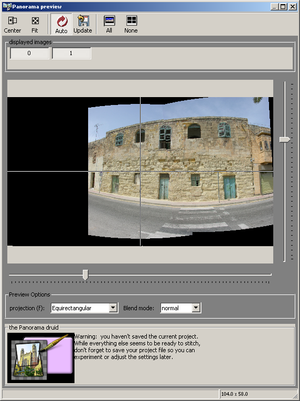Difference between revisions of "Hugin Preview window"
(add missing stuff) |
(__NOTOC__) |
||
| Line 83: | Line 83: | ||
[[Image:Hugin-061-win-preview 1.png|thumb|The Panorama-preview]] | [[Image:Hugin-061-win-preview 1.png|thumb|The Panorama-preview]] | ||
| + | __NOTOC__ | ||
[[Category:Software:Hugin]] | [[Category:Software:Hugin]] | ||
Revision as of 13:24, 7 May 2007
hugin provides a pop-up window showing a preview of the final stitched result. This is a smaller version of the output created by saving to a file in the hugin Stitcher tab with some differences:
- Reduced resolution input images are used, so some areas can appear blurred that will be sharp in the final output.
- Seams are not created, images are simply overlaid with the first image at the bottom of the stack and the last at the top.
- Blending by a tool such as enblend isn't shown.
- The brightness display of HDR and 16bit images is controlled by settings in the hugin Preferences, these settings are not used when stitching.
Buttons
Center
This button horizontally pans the output, changing the yaw of the remapped images so they fit to the centre of the output frame. This is useful if there is a lot of black space on the left or right of the output. This also performs a Fit, equivalent to the next button.
Note that centering a Rectilinear Projection or Fisheye Projection panorama will change the perspective, this may be unwanted.
Fit
This doesn't change any input image parameters, it just readjusts the output Field of View such that all the input images are visible. If the images are all off-centre, then there will be a lot of black space.
Straighten
Straightening the panorama optimises the roll and pitch of the input images without changing their relative positions, levelling the panorama in the process. This normally produces good results, if you need more accurate positioning, try adding vertical control points in the hugin Control Points tab.
Num. Transf.
This opens up a pop-up window that allows you to enter a numerical transform to rotate the input images without changing their relative positions - Effectively this rotates the entire panorama.
Enter roll, pitch and yaw values in degrees, note that you can also realign the panorama by left and right-clicking in the preview image itself, though this is not so precise.
Auto
Setting Auto will regenerate the preview every time something changes in the project. This can be slow with large preview windows, so you may want to disable Auto or reduce the size of the window.
Update
When Auto is unset, the preview doesn't regenerate when something changes in the project. Click Update to force a regeneration manually.
All
By default all input images are shown in the preview, however individual images can be enabled and disabled in the Displayed images section. Use the All button to return to the default and display all the images.
None
Similarly, hide all images with the None button, use this if you want to enable preview images one by one.
displayed images
Every input image in the preview has toggle button where display can be disabled or enabled.
In addition, if Optimize and stitch only images selected in preview window is selected in the Misc section of the hugin Preferences, then this display also controls the behaviour of the hugin Optimizer tab and the hugin Stitcher tab
Preview
The image window itself shows a representation of the final stitched output panorama, use the scroll bars to change the horizontal and vertical Field of View.
A Left-Click with the mouse in this image window will shift all the images, without changing their relative positions, such that the clicked point becomes the centre of the panorama.
A Right-Click with the mouse will rotate all the images, without changing their relative positions, such that the clicked point is level with the central horizon line.
Preview options
Projection
Use the drop down list to change the output projection of the panorama, the list is exactly the same as that in the hugin Stitcher tab. Note that for some projections, the scroll-bar sliders to change the Field of View are disabled. If you are having trouble, switch to Equirectangular Projection, adjust the field of view and switch back.
Blend mode
- normal blend mode simply shows all selected images as a stack.
- difference blend mode highlights differences between overlapping images. If the images are well aligned, there will be few differences and the overlap will appear mostly black.
